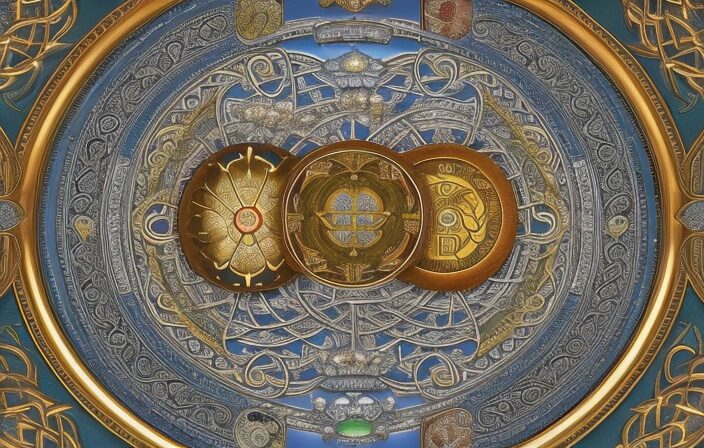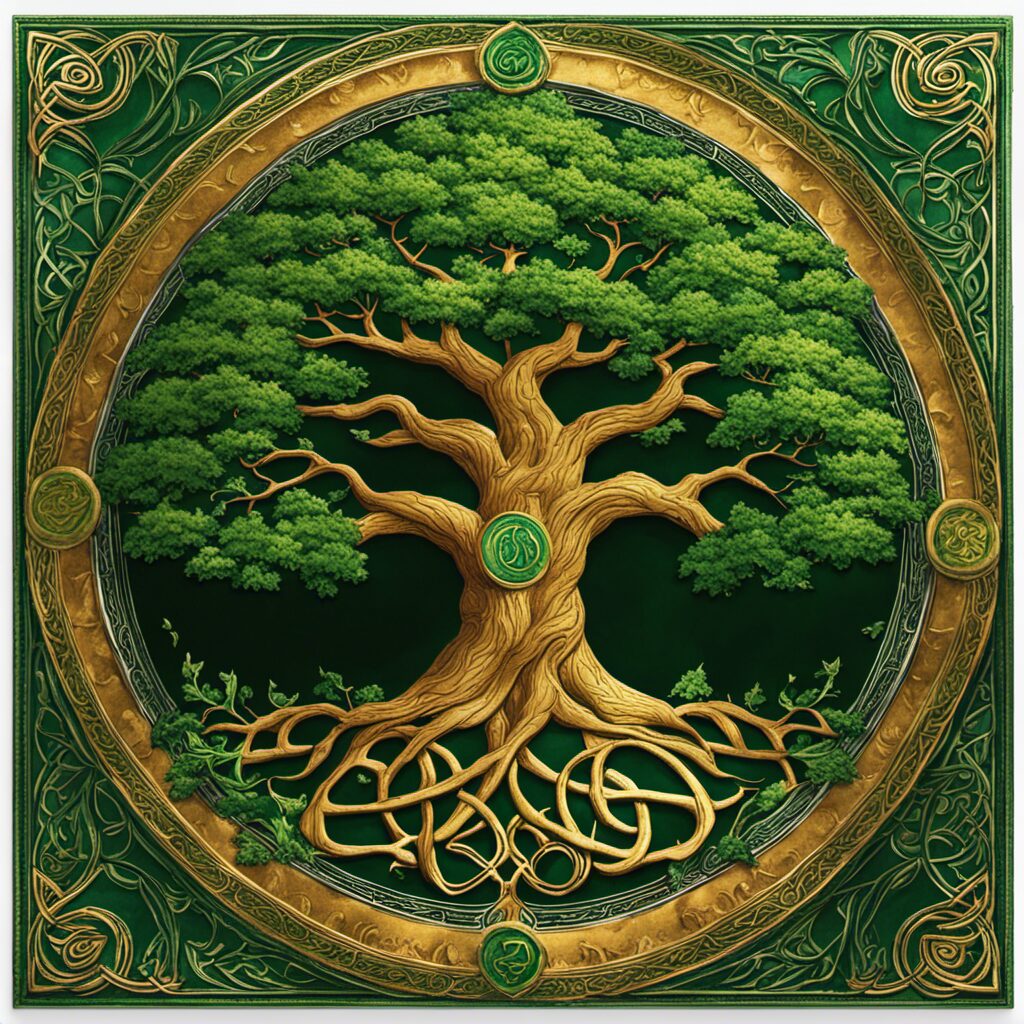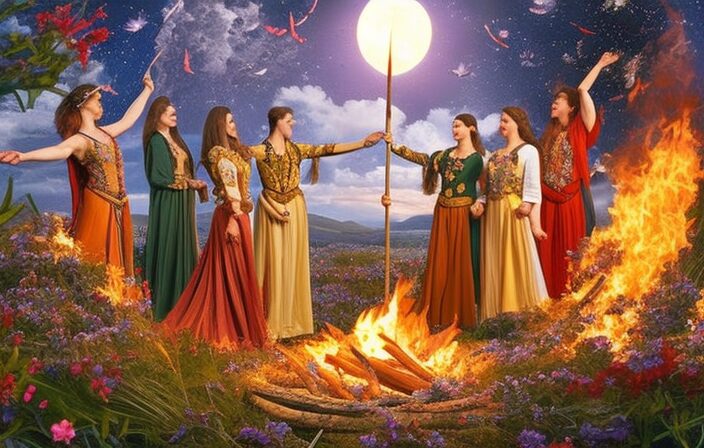In the intricate tapestry of ancient Celtic culture, the calendar played a vital role in organizing time and understanding cosmic influences. This article explores the intriguing interplay between the Celtic calendar and planetary alignments, shedding light on festivals, zodiac associations, and mythological deities associated with celestial bodies.
By examining both historical knowledge and contemporary interpretations, this scholarly examination aims to deepen our understanding of the profound connections between the Celtic calendar and the planets.
Key Takeaways
- The Ancient Celtic Calendar was a lunar-based system used to track agricultural and religious events, reflecting the Celts’ deep connection with nature.
- Planetary alignments were believed to have a significant impact on human life and cultural practices, playing a crucial role in astrology and making astrological predictions.
- Festivals and celebrations in the Celtic Calendar, such as Beltane, Samhain, and Imbolc, connected Celtic people with nature, honored ancestors, and reinforced social cohesion.
- The Celtic Zodiac is deeply rooted in Celtic beliefs and culture, with each zodiac sign associated with a specific planet, influencing various aspects of life including emotions, health, and relationships.
The Ancient Celtic Calendar


The Ancient Celtic Calendar is a lunar-based system that divided the year into distinct months and was used to track agricultural and religious events. The calendar consisted of twelve or thirteen months, each corresponding roughly to one lunar cycle. It was based on the movements of the moon rather than the sun, making it a lunisolar calendar. This meant that adjustments were made periodically to keep it in sync with the solar year.
The Celtic festivals played an important role in their society and were closely tied to their agricultural practices. These festivals marked key moments in the agricultural cycle, such as planting and harvesting seasons. They also celebrated religious events and honored deities associated with nature and fertility.
Ancient timekeeping among the Celts involved observing celestial bodies, such as stars and planets, which helped them determine when to perform certain activities or hold specific rituals. The position of stars and planets provided valuable information regarding navigation, agriculture, and religious ceremonies.
Overall, the Ancient Celtic Calendar served as a means for tracking time according to lunar cycles while also guiding their agricultural practices and religious observances. It reflected their deep connection with nature and their reliance on celestial observations for practical purposes.
The Influence of Planetary Alignments


Aligned celestial bodies have been found to have a significant impact on various aspects of human life and cultural practices. In the context of astrology, planetary alignments play a crucial role in making astrological predictions and interpretations. The alignment of planets is believed to influence the energies and vibrations that are present on Earth, which subsequently affect human behavior and experiences.
In Celtic rituals and ceremonies, the astrological significance of planetary alignments is highly regarded. The ancient Celts placed great importance on the movements of celestial bodies, believing them to hold spiritual power. Celtic rituals often incorporated observations of planetary alignments to determine auspicious times for specific activities such as planting crops or conducting religious ceremonies. Alignments were seen as opportunities for enhanced communication with deities or spirits, allowing practitioners to seek guidance or blessings.
Astrologers study the positions of celestial bodies, including planets, in order to understand their potential effects on individuals or events. Planetary alignments are considered particularly important as they indicate a concentration of energy that can amplify or intensify certain qualities associated with each planet. Astrologers use these alignments to make predictions about future events or interpret personality traits based on an individual’s birth chart.
Festivals and Celebrations in the Celtic Calendar


Festivals and celebrations in the Celtic tradition are deeply rooted in an intricate system of rituals and ceremonies that mark important moments in the annual cycle. These festivals have great cultural significance for the Celtic people, as they provide a means to connect with nature, honor their ancestors, and celebrate important agricultural milestones.
One such festival is Beltane, which takes place on May 1st and marks the beginning of summer. It is a time when bonfires are lit to symbolize purification and protection against harmful spirits.
Another significant festival is Samhain, celebrated on October 31st. This festival marks the end of harvest season and the beginning of winter. During Samhain, it was believed that the veil between the physical world and the spiritual realm was at its thinnest. Therefore, it was common for people to wear costumes as a means of disguising themselves from malevolent spirits.
Imbolc is another important festival celebrated on February 1st. It signifies the arrival of spring and represents new beginnings. It is associated with Brigid, the goddess of poetry, healing, and smithcraft.
These festivals not only provided opportunities for communal celebration but also played a crucial role in reinforcing social cohesion among Celtic communities by fostering a shared sense of identity through their unique cultural practices.
The Celtic Zodiac and Planetary Associations


The study of planetary influences on the Celts is an important aspect of understanding their astrology and belief system.
The Celts believed that each zodiac sign was associated with a specific planet, and these planetary associations played a significant role in Celtic astrology.
These connections between zodiac signs and planets provided insight into various aspects of an individual’s personality, characteristics, and destiny according to Celtic beliefs.
Planetary Influences on Celts
Astrological beliefs held by the Celts involved attributing specific planetary influences to various aspects of life. These beliefs, deeply rooted in their culture, shaped their understanding of the world and their daily lives. The Celts believed that the planets had a profound influence on different facets of human existence, including emotions, health, and relationships.
-
Influence on Daily Life:
-
The movement of celestial bodies was thought to affect individuals’ moods and behaviors.
-
Planetary positions determined auspicious times for certain activities such as harvesting or hunting.
-
Certain planets were associated with specific days of the week, affecting how people planned their tasks.
-
Connection to Nature:
-
The Celts saw a strong connection between the movements of planets and natural phenomena like tides and weather patterns.
-
They believed that understanding these planetary influences allowed them to live in harmony with nature.
-
Observing celestial events helped them navigate through seasons and agricultural cycles.
These astrological beliefs played a significant role in shaping Celtic society’s perception of time, fate, and their place within the larger cosmic order.
Zodiac Signs and Planets
In Celtic astrology, zodiac signs and horoscope play a significant role in understanding astrological predictions and personality traits.
The twelve zodiac signs in Celtic astrology are associated with specific periods of the year, each ruled by a particular planet. These zodiac signs include Birch (December 24 – January 20), Rowan (January 21 – February 17), Ash (February 18 – March 17), Alder (March 18 – April 14), Willow (April 15 – May 12), Hawthorn (May 13 – June 9), Oak (June 10 – July 7), Holly (July 8 – August 4), Hazel (August 5 – September 1), Vine (September 2 – September 29), Ivy (September 30 – October 27), Reed (October 28 – November 14).
Each sign possesses unique characteristics attributed to its ruling planet’s influence. For instance, individuals born under the Birch sign are said to be ambitious and driven due to their association with the planet Venus.
Celtic Astrology Connections
Utilizing the twelve zodiac signs and their corresponding periods of the year can provide valuable insights into individuals’ personality traits and potential life outcomes.
In addition to the commonly known Western zodiac, Celtic astrology also offers a unique perspective on celestial influences. The ancient Celts believed that each month was associated with a particular tree, which served as a symbol for various aspects of human nature. These Celtic astrology symbols encompassed not only personality traits but also provided guidance regarding an individual’s journey through life. The celestial influences represented by these symbolic trees were believed to shape one’s character and destiny.
For example:
- Birch (December 24 – January 20): Known as the tree of beginnings, it signifies renewal and fresh starts.
- Oak (June 10 – July 7): Symbolizes strength and endurance, representing those born during this period.
- Elder (November 25 – December 23): Signifies transformation and spiritual growth.
The Mythology and Symbolism of Celtic Planetary Deities


This discussion explores the role of deities in Celtic mythology, their significance in Celtic culture, and the symbolism associated with them.
Deities played a crucial role in Celtic society as they were believed to have control over various aspects of life such as nature, fertility, war, and craftsmanship.
The symbolism found in Celtic mythology often reflected the values and beliefs of the people, encompassing elements from nature, animals, and celestial bodies.
These myths and symbols not only shaped the spiritual practices of the Celts but also influenced their art, literature, and societal norms.
Deities and Their Roles
The deities in the Celtic calendar played distinct roles within their respective domains. These celestial beings were worshiped by the ancient Celts, who believed that they had control over various aspects of life. The roles of these deities can be categorized into three main sub-lists:
-
Nature: Many Celtic deities were associated with natural elements such as forests, rivers, and mountains. They were believed to have power over these elements and were revered for their ability to bring fertility to the land and ensure a bountiful harvest.
-
Warfare: Certain deities held dominion over warfare and battle. They were invoked by warriors seeking victory on the battlefield, offering prayers and sacrifices in hopes of gaining favor from these powerful entities.
-
Wisdom: Other deities were associated with wisdom, knowledge, and prophecy. These gods and goddesses served as guides for seekers of truth and enlightenment, providing insights into the mysteries of the universe.
Overall, deity worship was an integral part of Celtic culture, reflecting their deep connection with nature and their reverence for celestial beings.
Symbolism in Mythology
Symbolism in mythology is a recurring theme found across various cultures, often serving as a means to convey deeper meanings and universal truths. In the context of astrology, symbolism plays a significant role in understanding the mythological associations of celestial bodies.
Astrology views planets as archetypal symbols representing specific energies or qualities. For instance, the Sun represents vitality and self-expression, while the Moon symbolizes emotions and nurturing instincts. These symbolic associations have roots in ancient mythologies where gods and goddesses were attributed with particular traits or powers.
Influence on Celtic Culture
The previous subtopic explored the symbolism in Celtic mythology. Building upon that, this current subtopic delves into the influence of Celtic customs and their astrological significance.
The Celtic calendar was deeply intertwined with nature and celestial bodies, which influenced various aspects of their culture.
-
Festivals: The Celts celebrated agricultural festivals such as Beltane and Samhain, which were aligned with astronomical events like solstices and equinoxes.
-
Divination: Astrology played a significant role in Celtic divination practices. Druids interpreted celestial movements to make predictions about the future.
-
Symbolism: Celestial bodies held symbolic meanings in Celtic culture. For instance, the sun symbolized vitality and divine power, while the moon represented femininity and intuition.
These customs highlight how the Celts recognized the astrological significance of celestial bodies and integrated them into their daily lives for both practical and spiritual purposes.
Modern Interpretations and Applications of the Celtic Calendar


One approach to the modern interpretations and applications of the Celtic calendar involves examining its alignment with celestial bodies, such as planets. The Celtic calendar was a complex system that reflected the cyclical nature of time and the interconnectedness between humans and their environment. In recent years, there has been a growing interest in understanding how this ancient calendar can be applied and interpreted in contemporary contexts.
Modern interpretations of the Celtic calendar focus on its relevance for personal growth, spirituality, and connecting with nature. Some individuals use it as a tool for self-reflection, setting intentions, or planning activities based on the corresponding energies associated with each month or season. For example, aligning one’s actions with the energy of Beltane, traditionally celebrated on May 1st, may involve engaging in creative pursuits or nurturing relationships.
In terms of practical applications, some people integrate elements from the Celtic calendar into their daily lives through rituals or ceremonies. They might incorporate specific colors, symbols, or rituals associated with different months or seasonal transitions into their practices. Additionally, some businesses have embraced elements from the Celtic calendar as part of their branding strategies to evoke a sense of connection to nature and heritage.
Overall, modern interpretations and applications of the Celtic calendar offer individuals an opportunity to connect with ancient wisdom while finding relevance within contemporary contexts.
Conclusion
The Celtic calendar is an ancient system that played a significant role in the lives of the Celts. It was influenced by planetary alignments, which were believed to have a profound effect on human behavior and natural phenomena. This resulted in the creation of festivals and celebrations that were aligned with specific planetary events.
The Celtic zodiac further emphasized the connection between celestial bodies and human characteristics. The mythology surrounding Celtic planetary deities added depth and symbolism to this intricate calendar system.
Today, modern interpretations of the Celtic calendar continue to provide insights into how ancient cultures understood and interacted with the cosmos.
In conclusion, the Celtic calendar offers a fascinating glimpse into the beliefs and practices of an ancient civilization. Its focus on planetary alignments, festivals, zodiac signs, and mythological deities showcases their deep reverence for nature and celestial bodies.
As we delve into these ancient traditions, we can gain a greater appreciation for our own place in the universe, reminding us of the timeless adage: ‘As above, so below.’ By studying the intricacies of this calendar system, we can better understand our ancestors’ connection to both Earth and sky.




